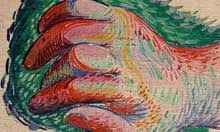An extraordinary cache of hundreds of works by Pablo Picasso, painted during his most creative period and worth a conservative estimate of €60m (£50.5m), has been uncovered at the home of a retired French electrician.
The collection of 271 paintings, drawings, sketches and lithographs, many of which were previously unknown, dates from 1900 to 1932.
Among the works are nine cubist collages worth at least €40m, a painting from his celebrated blue period, drawings and models for some of his most important works and portraits of his first wife, the Russian ballerina Olga Khokhlova.
French art experts have been poring over the unexpected treasures since they were discovered nearly three months ago. Extraordinary as the collection is, the story of how it was uncovered is almost as sensational and is now at the heart of a police investigation into how the works first disappeared and then remained hidden for almost 40 years.
On 9 September this year, an elderly man calling himself Pierre Le Guennec travelled from his home on the Côte d'Azur to Paris and made his way to the offices of the Picasso Administration, which manages the artist's legacy in rue Volney in the second arrondissement.
He was carrying an unremarkable suitcase and was accompanied by his wife who, like him, is in her 70s.
Shown into the office of Claude Picasso, 63, the late painter's son, who represents the artist's heirs and estate, he opened the case he had with him and produced 175 different works that, he claimed, were by Picasso. At first, those gathered in Claude Picasso's office suspected they were forgeries. But on close examination many of them were found to carry a numbering system known only to the painter.
The various works are from between 1900 and 1932, from the time when the young, unknown and penniless Picasso arrived in France from Barcelona to the beginning of his recognition as one of the world's greatest 20th century artists.
Picasso's early days in Paris, then the art capital of Europe, were marked by poverty and desperation. Legend has it he and his first friend, the French journalist and poet Max Jacob, burnt his paintings to stave off the cold.
Some of the works, such as the fragile cubist collages, reportedly produced in 1912 when critics described them as "painted proverbs", had been known to exist but were thought to have been lost when Picasso's studio was flooded and during successive house moves.

Others, including a watercolour from his blue period, gouaches on paper, several studies of hands painted on canvas, and around 30 lithographs as well as portraits of Khokhlova, until now were entirely unknown.
Le Guennec also produced two notebooks containing 97 previously unseen drawings, along with 59 photographs of other pieces. He told his astonished audience that Picasso and his wife Jacqueline had given him the various pieces after he installed alarm systems at the painter's various homes, including the celebrated La Californie in Cannes, the Chateau de Vauvenargues and the mill at Notre Dame de Vie in Mougins, where Picasso died.
The electrician explained the gifts he was carrying in his suitcase were given in the three years leading up to Picasso's death in 1973, but the full extent of the grand master's apparent generosity was only discovered when police raided Le Guennec's home at Mouans-Sartoux in the Alpes Maritimes in October, confiscating a total of 271 items. Le Guennec was later taken into custody by police, but was released and has not been charged with any crime.
The Picasso family has subsequently launched a legal action "against X" – meaning unknown persons – for receiving stolen goods. This is a common legal move in France allowing police and magistrates to investigate any number of possible suspects. Picasso's friends and family find Le Guennec's story hard to believe. They say Picasso was notoriously protective of his works, to the point that he was often reluctant to part with them even when they had been sold.
Claude Picasso told the French daily newspaper Libération that the discovery came after Le Guennec had sent him letters in January, March and April this year enclosing dozens of grainy photographs of various Picasso works he said he owned, and asking for certificates of authenticity.
Dismissing them as fakes because they did not appear in any catalogue or inventory of the artist's known work, Claude Picasso refused Le Guennec's requests. "Many of these pieces weren't dated, which shows they should never have left his studio," he said.
"When you look at my father's works he systematically dated everything. He also wanted to document what he knew would be the work of the century. He kept everything: letters, métro tickets, theatre and bullfight tickets. Even the string used to tie the many letters brought to him every day … he would say it could be recycled in a painting. He would never have let go of so many pieces of his oeuvre in one go."
He added: "To have given so much … it doesn't make sense, to be honest. It's true Pablo Picasso was quite generous, but he always dated, signed and dedicated his gifts, especially as he knew some would sell them to cover their needs."
He said it was "out of the question" that Picasso's last wife Jacqueline, who died in 1986, would have given Le Guennec the works.
The six family members who inherited his estate are now taking legal action for receipt of stolen goods, and the French office to prevent trafficking of cultural works is investigating.
Claude Picasso said the collection has a "historic importance" as it was produced during a "crucial period; a revolutionary movement in art". Representatives of Sotheby's and Christie's in Paris said that although the collection is unlikely to come up for sale, the discovery is "important, interesting and extremely exciting".
Le Guennec has denied stealing the works. "What will happen, will happen," he told Libération.
